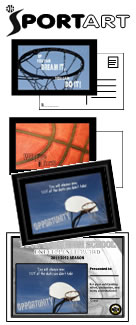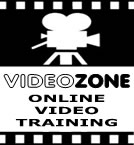Defensive Tips Straight From the Bible
(Basketball that is) by Sidney Goldstein copyright ©2001 revised 2004
Defense is, no doubt, the easiest skill to learn. Players can become experts in weeks, rather than the months or years that it takes to improve offensive performance. However, you cannot skip all the steps, starting at the end, zone defense, because you have to apply individual principles in the zone, not stand around like cattle.
These tips are in the form of principles and counterproductive beliefs that are directed to players. Details of how to learn defense are in our books and better yet, our videos. The principles tell you what to learn. Counterproductive beliefs are widely held ideas that prevent learning, because they do not hold true.
The Principles of Defense
1. Defensive body position enables you to move quickly in any direction. The feet are slightly greater than shoulder-width apart. The body is low to the ground with the knees bent like you are ready to start a race, a 2 step race. The back is straight, not bent. Put your weight on the balls of your feet. Tap dance by moving your feet one-two inches off the ground as quickly as possible. The fingers are spread apart ready to catch the ball.
2. In defensive position, there are two ways to move: one is just a full out sprint; the other is a jump-step or hop. The jump-step is used to play tight defense. Both movements must be practiced in defensive position. All other defensive principles depend on getting your movements together. An instant of improper movement like sliding gives the offense an opening.
3. You need to practice staying with the offensive player. Practice maintaining a distance of from 3 yards to as little as one foot from the defense.
4. Always force the offense to one side or the other whether or not they have the ball. You need to be aware of which way, right or left, the offense likes or wants to move, and then prevent them from doing so. Forcing involves setting up at about a 45 degree angle to the defense, one foot to the side. This positioning makes it easier for the defense to go around you one way and more difficult to go the other way.
Practice forcing two ways: one, practice forcing and staying with the offense as they bring the ball downcourt; two, practice forcing from each position around the basket: corners, sides, and straight away.
5. Defense is most important around the basket. This is priority number one. Prevent low post players from moving where they want to go. Cover a player jumping or cutting into the lane.
6. Boxing out is just not a defensive skill. Use it on offense as well. If you properly play defense around the basket, it is easy to box out.
7. Defending the pick can be tricky. It requires lots of communication and experience.
8. Proper strong-and-weak side defense is the key to effective team defense. Weak-side defenders (defenders far away from the ball, maybe on the other side of the court) must help out on the ball. Helping out involves watching carefully and moving to prevent offensive movement especially in the lane.
9. Hustle is a big part of defense. You must catch up to an offensive player who gets by you or pick up uncovered players going to the basket.
Counterproductive Beliefs
10. Learning on ball defense (covering the player with the ball) is more important than off ball defense (covering players without the ball). Nope both are important, but off ball defense is probably more so, because four players are off the ball at any moment; only one is on the ball. One-on-one, any offensive player can go around the defense. So, off ball players always need to help out. Off ball players must be in position to rebound as well.
11. Defense is difficult to learn. No. Defense is much easier to learn than offense. Not only is less skill involved, but there are also fewer skills to learn.
12. You can't teach or learn hustle. No. It is one of the easiest, if not the easiest, skill to teach. All of the players I ever coached hustled. One idea: play catch up by putting a defensive player at half court one step behind the defense. The defense attempts to catch up before the offense reaches the basket. To avoid collisions, the defensive player must run three feet ahead of the offense before cutting in front.
13. By playing 1-on-1 or 2-on-2 you can learn offense and defense simultaneously. A bad idea for several reasons. One, a poor offensive player will not give the defense a good workout. Two, players need to focus more on individual offensive techniques than scoring moves. Three, coaches will end up correcting the offense more than the defense. Forget the offense so you can concentrate solely on defense. To practice defense effectively, do not let the offense dribble.
14. Zones are easier to learn than person-to-person defense. Some coaches and players think that players just shift around in zones taking up space, not covering offensive players individually. Not so. Zones are more difficult to learn because you need to learn how the zone shifts in addition to all other defensive skills. While shifting in a zone, defenders need to play offense in the area using individual offensive principles.
15. It is okay to slide or cross your feet on defense. Only if you don't mind players running in for layups while you are covering them. You need your weight on the balls of your feet all the time, so you can change direction and move quickly. Sliding your feet, or crossing your legs, or even taking large steps on defense puts you in a position where you can't move for an instant: when you slide your feet together, you need to get them at shoulder width before you can move.; when you cross your legs while running like in a football drill, you need to uncross them before you can move; if you take large steps, then you must wait till the step is complete before moving. Remember the offense only needs an instant, maybe a tenth of a second to go by you. So you must be ready to run at every instant with your feet on the ground, weight on the balls of your feet in defensive body position.
------------------------------
The plays shown on this site are kept as simple as possible so to keep the interest of the reader. I’ve been to other sites where I get lost with so much play detail, not here. If coaches/players understand basic ball principles, these plays will work just fine. If you have a favorite play you would like to submit to our listing simply email me for details on how to get it done.
Coach O
|




